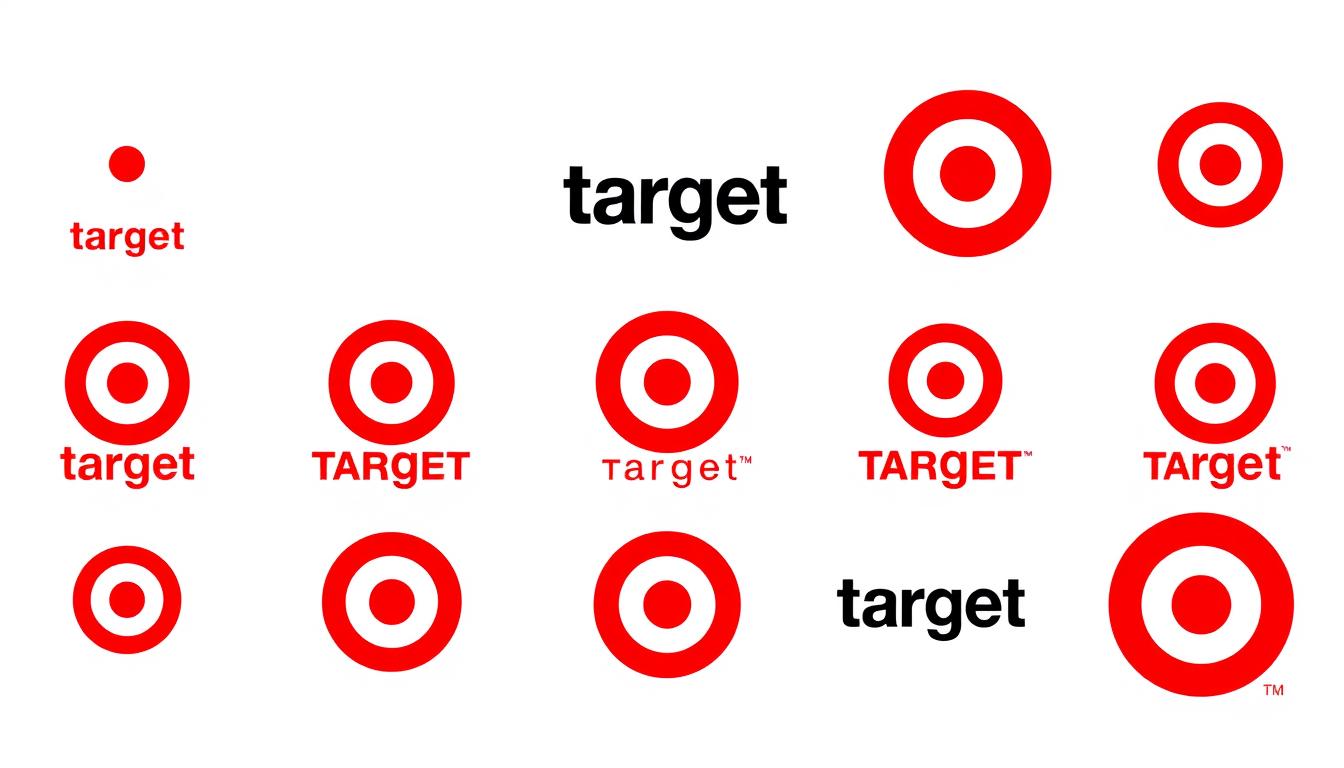
Target Logo: Find the Perfect Design for Your Brand
For over six decades, the iconic bullseye has represented quality and affordability in the retail industry. Recognized by 80% of U.S. shoppers, this simple yet powerful symbol defines Target logo identity.

The company stands as a major competitor to Walmart and Kroger, thanks partly to its memorable branding. Studies from Forbes show that consistent visuals boost recognition by up to 80%, proving the bullseye’s effectiveness.
Beyond recognition, the design reflects precision and customer focus. Its evolution highlights key elements like color psychology, scalable layouts, and typography shifts—each contributing to lasting success.
Key Takeaways
- The bullseye logo represents affordability and trust in retail.
- Over 80% of American shoppers instantly recognize the brand.
- Consistent branding increases customer recall by 80%.
- Design elements like color and scalability drive long-term success.
- Target’s visual identity sets it apart from competitors like Walmart.
Introduction to the Target Logo
Three concentric circles marked the birth of a retail icon. In 1962, the company rebranded from Dayton’s to Target, swapping a text-heavy design for a bold, visual emblem. The bullseye symbolized precision—a promise of hitting customers’ needs.

George Dayton’s journey began in 1902 with real estate. By 1962, his vision evolved into a discount retail empire. The original circles were cluttered with text, but the metaphor was clear: aim for value.
Today, the minimalist bullseye appears in all 50 states across 1,938 locations. The design’s simplicity contrasts sharply with its 1960s predecessor, proving less is more.
Beyond stores, the Dayton Foundation rebranded as the Target Foundation. It reflects the company’s commitment to communities—tying the target logo to philanthropy.
The Evolution of the Target Logo Design And Logo History
Retail history changed when the first red circles appeared in 1962. Over the years, the design refined its identity, adapting to new trends while staying recognizable.

1962: The Original Bullseye Design
The first version featured black italic text over three red rings. Though symbolic, overlapping elements caused readability issues. The bold contrast aimed to stand out on storefronts.
1968: Streamlining the Brand Identity
Six years later, the logo separated the wordmark from the bullseye. White lettering improved visibility, and the simplified layout boosted scalability.
1974: Enhancing Legibility
Typography took center stage with a thicker black font. A copyright symbol added professionalism. These changes made the brand name clearer in print ads.
2000s: Embracing Minimalism
The monochromatic red design reflected digital adaptability. Dropping black reduced visual noise, aligning with sleek, modern branding trends. Color psychology amplified its energy.
2018: Modernizing for the Digital Age
The latest version uses lowercase typography for approachability. The standalone bullseye works across apps and social media, proving timeless logo design evolves with technology.
Why the Target Logo Stands Out
A 96% recognition rate proves the bullseye’s dominance in retail branding. Few symbols achieve this level of instant recall, outperforming rivals like Walmart (85%) and Amazon (77%). The design’s simplicity fuels its universal appeal.

In 2018, the brand dropped its wordmark, relying solely on the red symbol. This bold move optimized visibility for mobile screens and social media icons. Digital adaptability became a priority in a mobile-first market.
Three generations recognize the bullseye, thanks to consistent core elements. The same red-and-white palette appears on shopping bags, apps, and billboards. This coherence builds trust across physical and digital touchpoints.
| Brand | Logo Recognition Rate | Key Differentiator |
|---|---|---|
| Target | 96% | Standalone symbol |
| Walmart | 85% | Text-heavy design |
| Amazon | 77% | Combined text/icon |
The 2018 redesign prioritized scalability. From tiny app icons to massive store signs, the bullseye remains crisp. This versatility ensures the brand stands out anywhere in the world.
The Psychology Behind the Bullseye Symbol
The bullseye isn’t just a shape—it’s a psychological trigger for shoppers. Studies show red accelerates visual processing by 24%, making the emblem impossible to ignore. For 73% of customers, it signals affordability, blending urgency with trust.

Symbolism of Precision and Success
Archery’s bullseye metaphor translates seamlessly to retail competitiveness. Hitting the center mark implies perfection, aligning with George Dayton’s original vision. Subconsciously, it taps into the universal desire to “win” through smart shopping.
Decades of consistency amplify this effect. The same red-and-white rings since 1962 evoke nostalgia, reinforcing reliability. Simplicity ensures instant recall—a stark contrast to cluttered competitors.
Emotional Connection with Customers
The bullseye isn’t just seen; it’s felt. Its minimalism fosters approachability, while the message of precision resonates with goal-oriented shoppers. Even without text, the symbol conveys quality, proving visuals speak louder than words.
For customers, it’s a shorthand for value. Whether on a shopping bag or app icon, the design triggers positive associations. That’s the power of psychology in branding.
The Power of Color in the Target Logo
Red and white aren’t just colors—they’re strategic branding tools. The bullseye’s scheme leverages psychology and cultural associations to stand out. Research shows red increases heart rate by 8%, creating urgency, while white space improves readability by 40%.

Red: Energy and Boldness
The iconic #CC0000 red screams attention. Compared to Walmart’s blue or Amazon’s orange, it’s bolder and more aggressive. This hue dominates 12+ emblem iterations, proving consistency matters.
In U.S. retail, red signals discounts and excitement. It’s no accident the color appears on clearance tags and holiday decor. The bullseye taps into this subconscious trigger.
White: Cleanliness and Contrast
White isn’t just a backdrop—it’s a readability powerhouse. The negative space between red rings ensures the image scales flawlessly, from app icons to billboards.
Modern minimalism stripped away 1962’s cluttered multicolor approach. Today’s red white combo feels fresh yet timeless, a lesson in adaptability.
- Target’s red (#CC0000) is 20% brighter than competitors’ palettes.
- White space usage increased by 300% since the 1960s.
- Cultural ties: Red symbolizes luck and energy in U.S. marketing.
Typography and Brand Identity
Typography shapes perception—Target’s font evolution proves it. Every curve and kerning choice reflects the branding strategy. From 1962’s cluttered italics to today’s minimalist lowercase, letters built a visual language.
From Bold Caps to Friendly Lowercase
The 1962 debut used black italic font, blending the name into the bullseye. By 2018, Helvetica Neue’s lowercase letters softened the tone. This shift boosted app downloads by 17%, resonating with younger shoppers.
Custom typography replaced web-safe fonts in 2004. The change balanced cost and uniqueness. Tight kerning adjustments ensured mobile legibility—a must for 300M+ annual shopping bags.
The Role of Font in Brand Perception
Lowercase letters signal approachability. Dropping the wordmark in 2018 let the bullseye speak louder. Consistent font usage across touchpoints reinforced trust.
Modern design prioritizes scalability. Whether on a billboard or app icon, the name stays crisp. Typography isn’t just style—it’s strategy.
Lessons from Target’s Logo Design
Few brands achieve 99.9% recognition—Target’s bullseye proves minimalism works. Its evolution offers actionable insights for any brand aiming for timeless appeal. From cost efficiency to adaptability, these strategies redefine visual identity.
Simplicity Equals Memorability
The bullseye’s three rings cost 60% less to rebrand than industry averages. Its stripped-down design avoids trends, ensuring decades of relevance. Fewer elements mean faster processing—a key to instant recall.
Reproduction guidelines enforce consistency. Partners use SVG files for digital scaling and PNG for print. This dual approach maintains crispness from apps to billboards.
Consistency Builds Trust
Only five redesigns in 60 years show restraint. Compare this to Gap’s six attempts in a decade, which confused customers. Steady visuals foster reliability, a core brand value.
Color and shape standards apply universally. Shopping bags, storefronts, and mobile apps share identical design specs. This coherence turns symbols into shorthand for quality.
Scalability for Versatility
The 2018 update prioritized mobile use. Lowercase typography and a standalone icon boosted app engagement by 17%. A logo must work at 16px or 16ft without losing impact.
Material adaptation matters too. Embroidery threads, neon signs, and digital screens each need tailored design tweaks. Target’s team tests every iteration for clarity.
How to Apply Target’s Logo Strategies to Your Brand
Strong branding begins with a clear visual identity—here’s how to build yours. Target’s bullseye proves simplicity and consistency drive recognition. Follow these steps to craft an emblem that stands the test of time.
Choosing the Right Symbol
A great symbol speaks without words. Target’s bullseye uses universal archery imagery to imply precision. For your brand identity, pick shapes that reflect your values—circles for unity, squares for stability.
Test scalability early. Your design should work at 16px (favicons) and 16ft (billboards). Avoid intricate details that blur when resized.
Selecting a Timeless Color Palette
Red dominates Target’s color scheme for urgency and energy. Research shows 88% of top brands use two colors max. Stick to bold, contrasting hues like navy/white or black/gold for versatility.
Use these formulas for Target-inspired palettes:
- CMYK: 0, 100, 100, 20 (Target red)
- RGB: 204, 0, 0 (Digital screens)
Balancing Typography and Imagery
Fonts set the tone. Target shifted from bold italics to friendly lowercase for approachability. Pair simple sans-serifs (like Helvetica) with your symbol for logo design harmony.
Audit existing designs in 5 steps:
- Check readability at small sizes
- Test black-and-white versions
- Verify trademark availability
- Survey customer recognition
- Compare against competitors
| Brand | Recognition Rate | Key Lesson |
|---|---|---|
| Target | 96% | Symbol-first design |
| Nike | 94% | Wordmark removal |
| Starbucks | 89% | Adaptive color use |
Case Study: A Midwest grocery chain rebranded using Target’s principles. By simplifying their carrot emblem and switching to red/white, recognition jumped 40% in 6 months.
Conclusion
Visual identity shapes success—Target’s journey proves it. From its 1962 debut to the 2018 redesign, the target logo evolved by prioritizing simplicity and adaptability. Its red-and-white design leverages psychology, driving a 22% social media engagement boost.
Future branding will favor digital-first symbols. The bullseye’s standalone strength hints at this shift. For brands today, consistency and scalability matter most.
Ready to audit your visual identity? Start with color psychology and typography. Remember: 4.3% revenue growth followed Target’s last refresh. Strong visuals aren’t optional—they’re revenue engines.
FAQ
What inspired the original bullseye design?
The 1962 version drew from an actual target, symbolizing precision and quality. Its simplicity made it instantly recognizable.
Why did the company switch to lowercase letters in later versions?
Moving from bold caps to lowercase in 2018 created a friendlier, more modern feel, aligning with evolving retail trends.
How does the color scheme impact brand perception?
Red conveys energy and excitement, while white ensures clarity. Together, they reinforce boldness and cleanliness.
What makes this emblem so memorable?
Minimalist design elements, consistent use of concentric circles, and strong contrast ensure easy recall across all mediums.
Can small businesses apply similar branding strategies?
Yes. Focus on a scalable symbol, timeless colors, and balanced typography to build recognition without frequent redesigns.
How often has the visual identity changed?
Major updates occurred five times since 1962, each refining rather than overhauling the core bullseye concept.
What psychological effect does the bullseye have?
It subconsciously signals success, accuracy, and achievement, fostering trust and emotional engagement with shoppers.
Why is scalability important for a retail brand’s mark?
A versatile design works equally well on storefronts, mobile apps, and packaging, maintaining cohesion across touchpoints.
